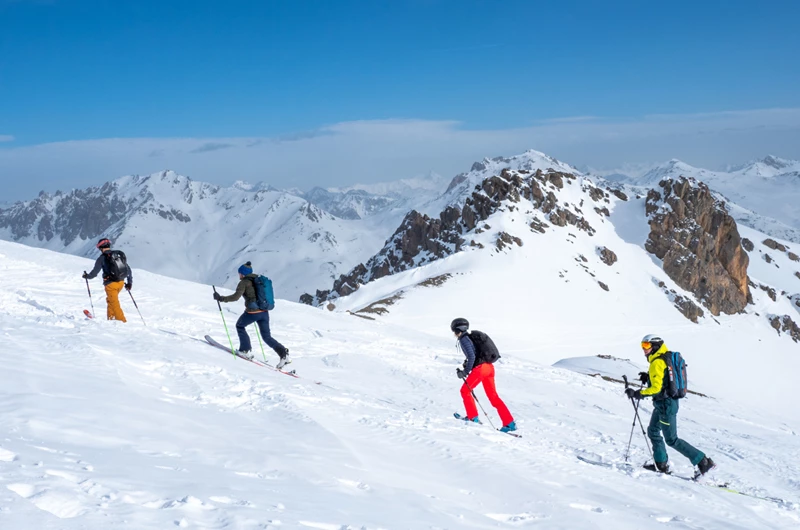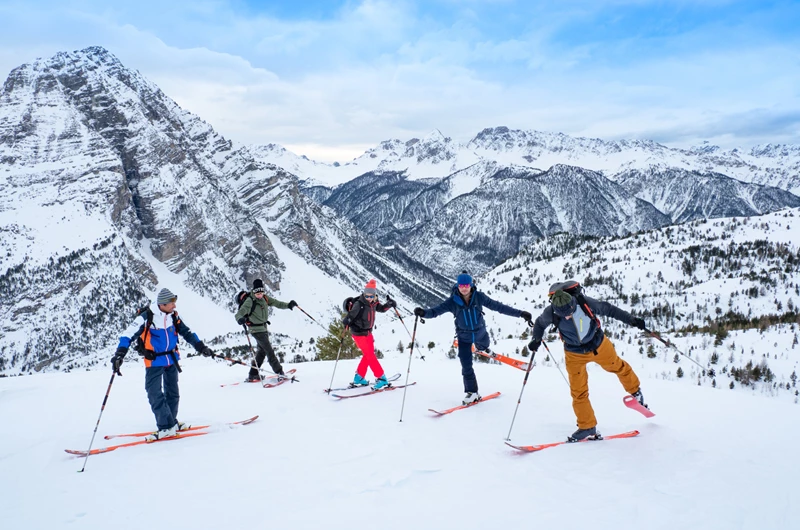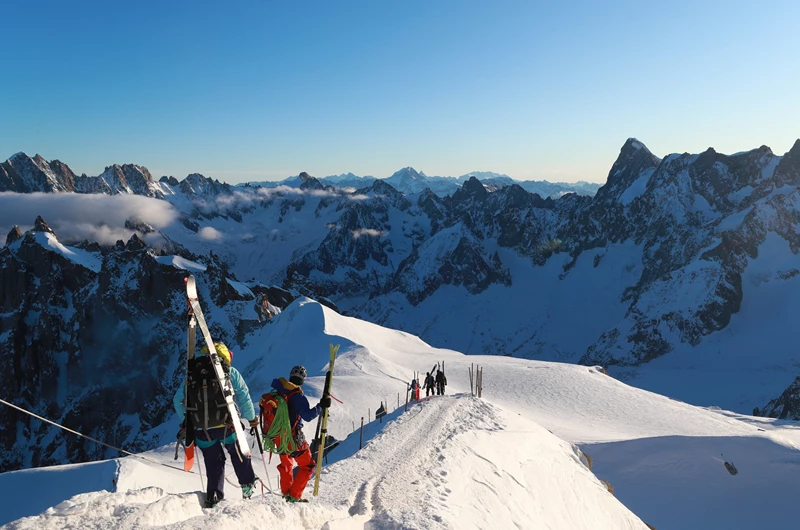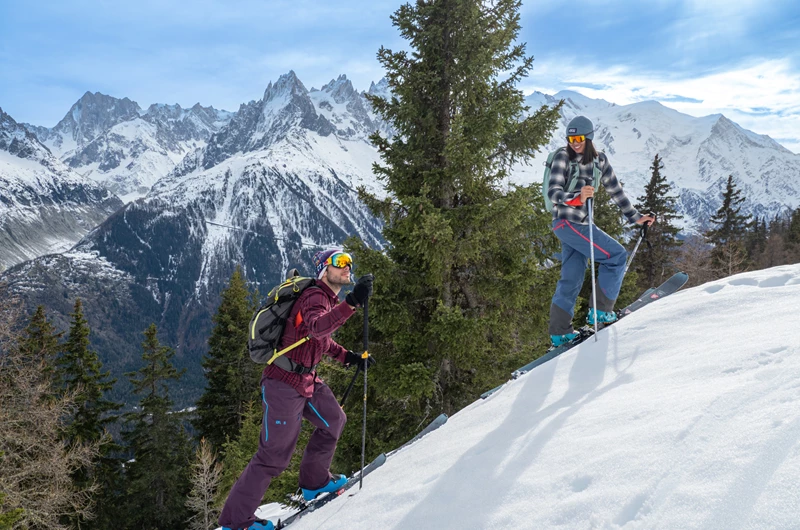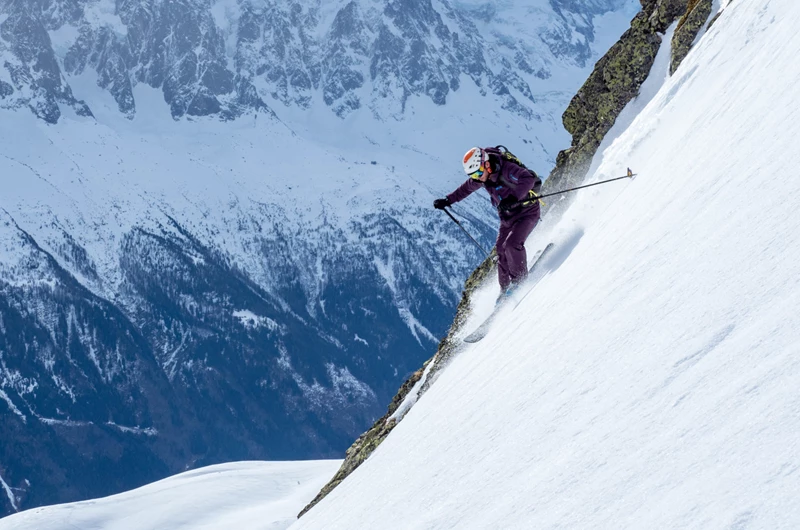Ski Touring
There are so many reasons as to 'why'. Ski touring opens so many dimensions when it comes to skiing, the most obvious one being you can go where the ski lifts can't, which means you can also go where the masses can't, which means you get the benefit of escaping the crowds as well making fresh tracks! However, there are some things you may want to know before you book, namely; equipment required, fitness levels, technique as well as the times of year. Once you know some of these you will be better prepared to book... or not!
Always included in our holidays

Full ski touring equipment (excluding some expert level courses)

Liftpass

Instruction or guiding

Accommodation

All meals

Friendly & social atmosphere
You have probably looked at ski tourers and wondered 'how are they walking uphill without sliding backwards?' but it is actually quite simple.
Underneath the ski is something called a 'skin' which has a hair like structure on one side and an adhesive on the other side. The adhesive part sticks to the bottom of the ski, and the 'hair' goes on the snow. The 'hair' goes in one direction which allows the ski to glide forwards but prevents it from sliding backwards down the slope. There are usually clips at both the front and the back of the ski.
Then there are the bindings and the boots. The key thing for the bindings is that the heel lifts, pivoting around the front part of the binding. There are two types of ski touring binding; 'pin' whereby there are two pins that clip in to the front of you boot, and a more basic binding which is essentially a normal binding that allows the heel to be released and the front part of the binding to pivot.
Boots are similar to standard boots, however they have a 'walk mode' which allows a bit more ankle flexion. Depending on the bindings being used, you may have 'tech inserts' which are two metal holes essentially on the toe to allow the pins to go in.
Something worth remembering is that you can become quite warm whilst ski touring, even in such a cold environment. Managing this is important, and generally speaking layers is the answer - being able to take layers off or put them on helps manage your temperature. The pants you wear should also allow for a good range of movement, not rock climbing amounts but enough to take some big steps and twist a bit.
This of course means a backpack that can carry these layers, plus food and water is important. Depending on what course or tour you are doing, a backpack that can carry skis may be required.
This equipment is included in most of our trips, but check the activity description on your course. On top of standard ski equipment:
- Sunglasses and goggles, as goggles can become sweaty
- Backpack (should be able to carry skis depending on tour)
- Avalanche equipment (shovel, transceiver, probe)
- Ski touring bindings
- Ski boots with walk mode
- Skins
This is just an example of what is required to do basic and non glaciated ski tours.
For more advanced ski tours, depending on the specific tour you may require; rope, ice axe, crampons, harness, ice screws, belay device, a few slings and some screw gate carabiners.
Ski touring can be quite demanding physically, but it is so rewarding. It is more demanding than hiking due to the weight - skis, skins, and boots are heavy enough in their own right and they are attached to your feet. Then you need to carry water and food, plus extra layers and any other equipment you need. And unless you are at high latitude, the chances are this will all be at altitude too where the air is thinner and the amount of usable oxygen is reduced, thus putting an extra strain on your body.
For our introduction course you do not need to be super fit, but it is suggested you are regularly active and have experience trekking.
Basic technique is a bit like walking, whilst dragging your toes on the floor behind you and then pushing your forward foot further forwards than usual. The sensation at first is odd, but you quickly get used to it! Be conscious of using your poles for balance.
For going up: you may have seen some zig zags going up a slope when you have been in the mountains before, a bit like a hiking trail forged in the snow. These tracks are formed by ski tourers traversing with a slight incline and then executing a 'kick turn', where they change direction and begin the traverse the other way. The slope angle determines the frequency of the tracks and their proximity to each other; closer tracks typically means a steeper slope. Eventually when a slope is too steep, you will normally take your skis off and attach them to your bag before boot packing up. Kick turns are difficult to master and take a lot of practice, especially on steep slopes!
Typically the ski touring 'season' is at its peak in the spring, rather than at the beginning of winter. This is for a variety of reasons, mainly because the snowpack is at its deepest and its most stable (thus lower avalanche risk), the weather is more settled, the days are longer and you get the ever desirable 'spring snow' - the only snow that comes second to powder.
Whilst you can do ski touring trips at any time throughout the season, the bigger adventures (such as hut to hut tours) and more exposed tours are not typically done until early spring, or at least until the weather changes. This can be from mid March onwards typically, however it does depend on the weather.
We have a range of courses for both first time ski tourers and experts alike. There are four levels of ski touring ability across our courses.
- Ski Tour Level 1 - Advanced level skier with some off piste experience, with no previous ski touring experience.
- Ski Tour Level 2 - A small amount of ski touring experience and an advanced to expert level off piste skier. You have completed a ski tour and practiced kick turns.
- Ski Tour Level 3 - Experienced ski tourer and off piste skier. Expert level off piste skier, confident on all terrain, with a good level of mountain safety awareness. You are very fit and are comfortable hiking at altitude for several hours. You have mastered kick turns and keeping pace.
- Ski Tour Level 4 - You are an expert level off piste skier, ski mountaineer and a seasoned ski tourer in very good shape. You have a wealth of ski touring experience and have completed a number of long and challenging ski tours.
Which courses you can do depends on your level. It is always better to understate your ability in the mountains if you are at all unsure, especially since if your level is not up to standard it could result in you being removed from the course with no refund offered.
Trips are either based out of the UCPA centre, doing 'day tours' and coming back to the centre, or they are 'hut to hut' trips whereby you ski from the UCPA centre to a mountain refuge and so on. There are a couple which are similar to the hut to hut but they stay in hotels/hostels and BnBs.
For those new to ski touring, start out with any of the 'Introduction to Ski Touring' courses, the trips go over the basics and give you the foundations to develop your ski touring on top of.
Centre based ski tours (one night or less in a mountain refuge):
Level 1:
- Introduction to Ski Touring
- Intro to Off Piste Skiing & Ski Touring
- Ski Tour Introduction
Level 2:
- Ski Tour - Cham Valley
Level 3:
- Ski Tour - Mont Blanc Massif
Hut to hut (or other accommodation to accommodation) ski tours:
Level 2:
- Mont Blanc Massif (one night)
- Val Formazza, Italy
- Short Break 4 Day Val Ferret, Italy
- Simplon
Level 3:
- Grand Jorasses
- Silvretta Alps
- Short Break 4 Day Aiguille Rouges
Level 4:
- Chamonix Zermatt Classic
- Gran Paradiso Haute Route
- Haute Route Chamonix Zermatt Original
- Saas Fee - Zermatt
View all dates & prices for Ski Touring
Prices from
What our clients say about us!
Subscribe to our Newsletter
Join our newsletter and get news in your inbox every week! We hate spam too, so no worries about this.
